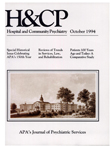A Retrospective View of the Affiliation of Occupational Therapy and Psychiatry
Abstract
In 1964 Bartemeier (1) expressed concern about the distancing of psychiatry from occupational therapy and emphasized the need for conjoint efforts. At the 1993 Institute on Hospital and Community Psychiatry, psychiatrist Marianne Klugheit (9) challenged occupational therapists "to wake us up." Emphasizing the potential of occupational therapy in community mental health programs, she stressed the need for occupational therapy to demonstrate to the physician the critical value of such service.
As each profession matures and clarifies and refines its domain, roles and expectations change. In its youth, occupational therapy was the agent for psychiatry. It relied on and grew from the leadership and support of psychiatry, discovering in the process its own unique identity and potential. Perhaps we can expect the affiliation of the two disciplines to follow the evolution of the child-parent relationship. As the child matures and establishes his or her efficacy and as the onus of parental responsibility diminishes, a new plateau is reached; it is a time charactenized by mutual respect, shared perspective, and productive dialogue. The challenge of collaborative endeavor is ours.
Access content
To read the fulltext, please use one of the options below to sign in or purchase access.- Personal login
- Institutional Login
- Sign in via OpenAthens
- Register for access
-
Please login/register if you wish to pair your device and check access availability.
Not a subscriber?
PsychiatryOnline subscription options offer access to the DSM-5 library, books, journals, CME, and patient resources. This all-in-one virtual library provides psychiatrists and mental health professionals with key resources for diagnosis, treatment, research, and professional development.
Need more help? PsychiatryOnline Customer Service may be reached by emailing [email protected] or by calling 800-368-5777 (in the U.S.) or 703-907-7322 (outside the U.S.).



